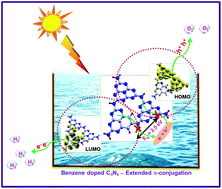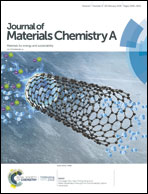Extending the π-electron conjugation in 2D planar graphitic carbon nitride: efficient charge separation for overall water splitting†
Abstract
We report direct overall pure water splitting by visible light excited graphitic carbon nitride incorporated with conjugated aromatic rings without using sacrificial agents. We fabricated modified graphitic carbon nitride polymer samples by copolymerization of melamine with 2,4,6-triaminopyrimidine and 1,3,5-triaminobenzene, containing few-carbon (pyrimidine) to all-carbon (benzene) aromatic rings. Solid state 13C NMR shows that the core molecular skeleton of g-C3N4 remained intact even after the incorporation of benzene and pyrimidine aromatic rings into the g-C3N4 chemical structure. Upon substitution of benzene aromatic rings in the place of triazine rings, the optical band gap energy of g-C3N4 is reduced down from 2.8 eV to 2.1 eV with negative shifts of valence and conduction bands due to the formation of defects like nitrogen vacancies. DFT calculations predict that the benzene doped carbon nitride polymer has localized charge densities over valence band maxima and conduction band minima in different parts of heptazine rings, which assist in reducing the recombination rate of the charge carriers. The benzene ring incorporated carbon nitride photoelectrode shows higher photocurrent with less charge transfer resistance than the parent g-C3N4 and pyrimidine doped g-C3N4 polymers. This demonstrates the importance of the extended conjugation in g-C3N4 due to the presence of aromatic benzene rings. This is further corroborated by photoluminescence and electron paramagnetic resonance measurements. As a result, the benzene ring incorporated carbon nitride is more active than the pyrimidine ring incorporated carbon nitride for solar water splitting. The benzene ring incorporated carbon nitride polymer directly splits water and generates about 7 μmol h−1 of hydrogen with an apparent quantum yield of 1.6% at 450 nm in the absence of sacrificial reagents, achieving a turnover number of 1.6.

- This article is part of the themed collection: International Year of the Periodic Table : Low Dimensional Carbon Systems


 Please wait while we load your content...
Please wait while we load your content...